Spinal Canal Stenosis
Updated:
(Also known as Spinal Stenosis, Lumbar Stenosis, Foraminal Stenosis, Lumbar Spinal Stenosis, Vertebral Canal Stenosis)
N.B. This article primarily pertains to spinal canal stenosis secondary to general degenerative changes. For appropriate advice on spinal stenosis secondary to a lumbar disc bulge or spondylolisthesis, please see the relevant article.
What is spinal canal stenosis?
Spinal canal stenosis is a condition characterised by narrowing of the space in the spine primarily responsible for housing the spinal cord (known as the spinal canal or vertebral canal). It is most commonly caused by age-related changes to the spine.
The spine comprises of many bones known as vertebrae each of which has a large hole in its centre (figure 1). Because these bones are situated on top of each other, their holes line up, forming the spinal canal. This canal provides protection and space for the spinal cord and nerves to travel from the brain to the rest of the body. Each vertebra connects with the vertebra above and below via two types of joints: the facet joints on either side of the spine and the disc centrally (figure 2).
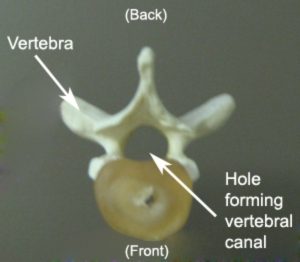
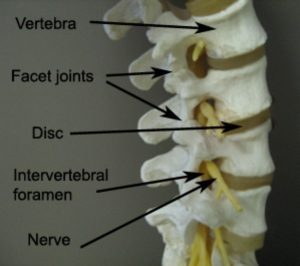
Over time, gradual wear and tear to the discs, joints and bones of the spine can occur resulting in degenerative changes to the spine. These degenerative changes may include osteoarthritis, reduced disc height, disc bulging or protrusion, loss of joint cartilage, bony spurring (osteophytes), thickening of ligaments or bone and vertebral slipping or malalignment. Some of these changes may also occur following trauma or due to a specific incident (e.g. a bulging disc). When these or other changes, in isolation or combination, result in narrowing of the spinal canal, the condition is known as spinal canal stenosis. As the condition progresses, the narrowing may place pressure on the spinal cord resulting in a variety of symptoms.
Whilst spinal stenosis can occur at any age, it is most common in those who are greater than 60 years of age.
Causes of spinal canal stenosis
Spinal canal stenosis is a condition that often occurs over time due to gradual wear and tear associated with overuse or aging. It may be particularly common in patients with a history of lower back pain or trauma to the spine or in those with sedentary lifestyles or lifestyles that have involved large amounts of lifting, bending, twisting or sitting activities.
Spinal Canal Stenosis may also commonly occur over a shorter period of time due to a specific incident or following repetitive or prolonged sitting, bending, lifting or twisting forces. In these instances, damage to an intervertebral disc may occur causing the disc material to bulge or herniate into the spinal canal (see Lumbar Disc Bulge).
Occasionally this condition may occur following traumatic injuries, such as a motor vehicle accident resulting in vertebral fractures or dislocations, or less commonly, due to other space occupying lesions, such as tumours or cysts.
In a small percentage of patients, hereditary factors such as congenital narrowing of the spinal canal, or forward slipping of one vertebrae on another (Spondylolisthesis) may be present at birth increasing the likelihood of the condition developing.
Below is a list of some of the most common factors which may in isolation or combination cause the spaces in the spinal canal to narrow:
- Disc bulging or protrusion
- Osteoarthritis of the spine (Spinal Degeneration)
- Bony spurring (osteophytes)
- Thickening of ligaments
- Vertebral malalignment or slipping (Spondylolisthesis)
- Facet Joint degeneration
- Rheumatoid arthritis
- Spinal fractures or dislocations
- Spinal tumours or cysts
It is important to diagnose the precise cause of the spinal canal stenosis, as treatment for the various conditions or causes can differ markedly.
Signs and symptoms of spinal canal stenosis
Spinal canal stenosis is most commonly seen in older patients who have degenerative changes to their spine. Patients with minor canal stenosis may experience little or no symptoms. As the condition progresses patients may begin to experience lower back pain, ache and / or stiffness. In more severe cases involving spinal cord compression, severe pain, muscle spasm, shooting pain, pins and needles, weakness, numbness or burning sensations may be experienced in the lower back, buttocks, legs or feet.
Generally, patients with this condition experience an increase in symptoms during activities that repetitively or continuously straighten or extend the spine (figure 3). Symptoms may also increase during activities that place weight on the spine (e.g. lifting, prolonged standing, walking etc.). Symptoms tend to ease during activities that bend the spine (e.g. sitting) or take weight off it (e.g. lying down).
In patients who have spinal canal stenosis secondary to a lumbar disc bulge, the condition may have an almost opposite response to movement patterns, with symptoms typically deteriorating during prolonged or repetitive sitting or bending forwards activities and improving with activities that straighten or extend the spine. For more information see Lumbar Disc Bulge.
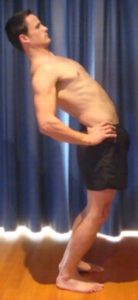
Diagnosis of spinal canal stenosis
A thorough subjective and objective examination from an experienced physiotherapist combined with appropriate investigations such as an X-Ray, CT scan or MRI are usually required to confirm diagnosis of spinal canal stenosis and determine the underlying cause of symptoms.
Treatment for spinal canal stenosis

Members Only ContentBecome a PhysioAdvisor Member to gain full access to this exclusive content. For more details see Become a Member. Already a member? Login Now
Prognosis of spinal canal stenosis
Although little can be done to reverse the degenerative changes to the spine commonly associated with this condition, most patients can have a good outcome with appropriate management. Many patients with mild to moderate degenerative changes and spinal stenosis can often experience little or no symptoms with appropriate management and remain active with some lifestyle modifications. Patients with more severe stenosis can also demonstrate significant improvements with appropriate management, although typically, they may require more significant lifestyle modifications and often experience more severe symptoms and functional limitations.
Physiotherapy for spinal canal stenosis

Members Only ContentBecome a PhysioAdvisor Member to gain full access to this exclusive content. For more details see Become a Member. Already a member? Login Now
Contributing factors to the development of spinal canal stenosis
There are several factors that may contribute to the development of this condition. These factors need to be assessed and where possible, corrected with direction from a physiotherapist and may include:
- age (> 40 years)
- a lifestyle that has involved large amounts of lifting, sitting, bending or twisting
- history of injury or trauma to the lower back
- being overweight
- excessive or inappropriate activity
- inadequate recovery periods from activity
- poor posture
- lumbar spine stiffness
- poor core stability
- muscle weakness or tightness
- muscle imbalances
- a sedentary lifestyle
- inappropriate lifting technique
- biomechanical abnormalities
- hereditary factors
- poor diet
Other intervention for spinal canal stenosis
Despite appropriate physiotherapy management, some patients with this condition continue to deteriorate. When this occurs, other intervention may be required. This may include pharmaceutical intervention, investigations such as an X-ray, CT scan or MRI, corticosteroid injection, the use of supplements such as glucosamine, chondroitin or fish oil, or assessment from a sports doctor, orthopaedic specialist or neurosurgeon. The treating physiotherapist can advise on appropriate management and can refer to the appropriate medical authority if it is warranted clinically. In more severe cases of spinal canal stenosis surgery may be required to relieve the pressure on the spinal cord.
Exercises for spinal canal stenosis
The following exercises are commonly prescribed to patients with this condition secondary to spinal degeneration and associated changes (such as disc narrowing, facet degeneration, bony spurring and thickening of ligaments and bone). You should discuss the suitability of these exercises with your physiotherapist prior to beginning them. Generally, they should be performed 3 times daily and only provided they do not cause or increase symptoms.
Your physiotherapist can advise when it is appropriate to begin the initial exercises and eventually progress to the intermediate, advanced and other exercises. As a general rule, addition of exercises or progression to more advanced exercises should only take place provided there is no increase in symptoms.
For appropriate exercises for spinal stenosis secondary to a herniated or bulging disc or spondylolisthesis, please see the relevant link below:
Initial Exercises
Transversus Abdominus Retraining
Slowly pull your belly button in “away from your belt line” and breathe normally. Your rib cage should remain relaxed and should not elevate during this process. You should be able to feel the muscle contracting if you press deeply 2cm in from the bony process at the front of your pelvis (figure 4). Practise holding this muscle at one third of a maximal contraction for as long as possible during everyday activity (e.g. when walking etc.) provided it is pain free. Repeat 3 times daily.
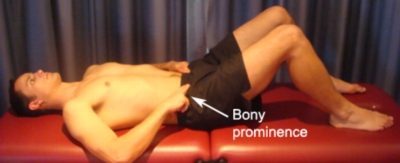
Rotation in Lying
Begin this exercise lying on your back as demonstrated (figure 5). Slowly take your knees from side to side as far as you can go without pain and provided you feel no more than a mild to moderate stretch. Repeat 10 times provided there is no increase in symptoms.
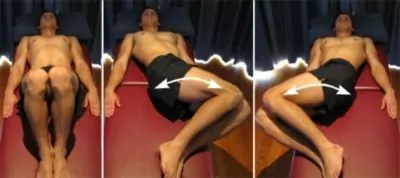
Hip Flexion
Slowly take your knee towards your chest as far as you can go without pain and provided you feel no more than a mild to moderate stretch (figure 6). Use your hands to gently bring your knee closer to your chest. Repeat 5 – 10 times on each leg provided there is no increase in symptoms.
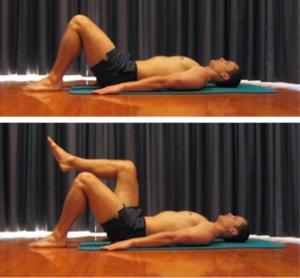
Intermediate Exercises

Members Only ContentBecome a PhysioAdvisor Member to gain full access to this exclusive content. For more details see Become a Member. Already a member? Login Now
Advanced Exercises

Members Only ContentBecome a PhysioAdvisor Member to gain full access to this exclusive content. For more details see Become a Member. Already a member? Login Now
Other Exercises

Members Only ContentBecome a PhysioAdvisor Member to gain full access to this exclusive content. For more details see Become a Member. Already a member? Login Now
Rehabilitation Protocol for spinal canal stenosis

Members Only ContentBecome a PhysioAdvisor Member to gain full access to this exclusive content. For more details see Become a Member. Already a member? Login Now
Physiotherapy products for spinal canal stenosis
Some of the most commonly recommended products by physiotherapists to help patients with this condition include:
-
 Wheat Bags
Wheat Bags -
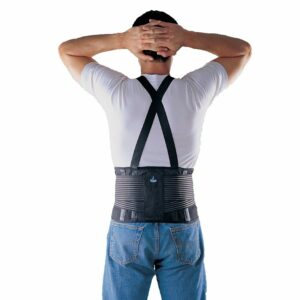 Oppo Industrial Back Support (OPP2169)
Oppo Industrial Back Support (OPP2169) -
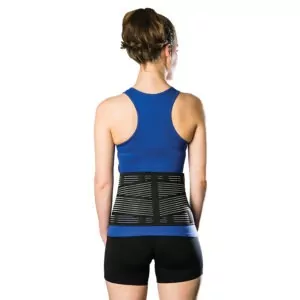 AllCare Ortho Light Back Support
AllCare Ortho Light Back Support -
 Premium Strapping Tape 38mm (Victor)
Premium Strapping Tape 38mm (Victor) -
 AllCare Pro-TENS Machine
AllCare Pro-TENS Machine -
 AllCare Spikey Massage Ball
AllCare Spikey Massage Ball -
 Fixomull Stretch 5cm x 10m
Fixomull Stretch 5cm x 10m -
 AllCare Instant Cold Pack (15 x 25cm)
AllCare Instant Cold Pack (15 x 25cm) -
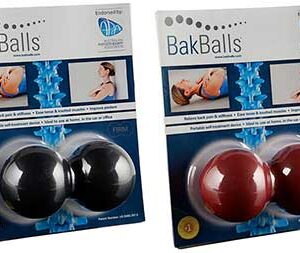 BakBalls
BakBalls -
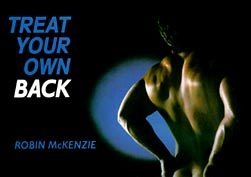 McKenzie Treat Your Own Back Book
McKenzie Treat Your Own Back Book -
 Lumbar Rolls (‘D’ Shaped)
Lumbar Rolls (‘D’ Shaped)
To purchase a physiotherapy product for spinal canal stenosis, click on one of the above links or visit the PhysioAdvisor Shop.
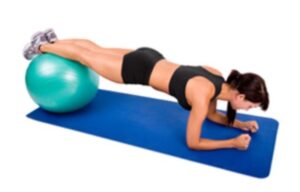 More Exercises
More Exercises
- Lower Back Stretches.
- Lower Back Strengthening Exercises.
- Basic Pilates Exercises.
- Cardiovascular Exercise.
- Core Stability Exercises.
Recommended Reading
- When to use Ice or Heat
- Initial Injury Management & the R.I.C.E. Regime.
- Safe Lifting
- Ergonomic Computer Setup
- Investigations
- Back Taping Techniques
- Correct Posture
- Lower Back Pain Diagnosis Guide
Find a Physio for spinal canal stenosis
Find a physiotherapist in your local area who can treat spinal stenosis.
Become a PhysioAdvisor Member

Link to this Page
If you would like to link to this article on your website, simply copy the code below and add it to your page:
<a href="https://physioadvisor.com.au/injuries/lower-back/spinal-canal-stenosis”>Spinal Canal Stenosis – PhysioAdvisor.com</a><br/>PhysioAdvisor offers detailed physiotherapy information on spinal canal stenosis and lumbar stenosis including signs and symptoms, diagnosis, treatment, exercises, rehabilitation protocol and more...
Return to the top of Spinal Canal Stenosis.




